There were five of us on the Nankoweap Trail hike last month: Canyon John, AKA John Laneve, 58; David McDonald, 60; David’s brother, Jim, 62; Lenny Frye, 63, and me. I’m 75.
![Lenny Frye [LtoR], Pat Stith, Jim McDonald, David McDonald, John Laneve](http://patstith.com/wp-content/uploads/2017/11/Group-shot-300x171.jpg)
Lenny and John still live in Lynchburg. The McDonald brothers moved away. Jim lives in Arizona, David in Connecticut.
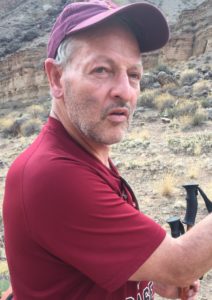
All four of them have desk jobs but they can hike, especially David, a former long distance runner who, according to his wife, spends way too much time in the gym. For this hike he told me he trained upwards of two hours a day for a month, on stair-stepper and an inclined treadmill – carrying a backpack weighing 35 pounds to start and then adding more weight later on.
* * *
Canyon John and Lenny were the most experienced canyon hikers in our group but the first time they tried to hike the Nankoweap, in 2007, they couldn’t get past the first really narrow part. Lenny said it was “skinnier” then than it is now, i.e., more dangerous.
“I got maybe 20 feet out there and froze up,” Canyon John said. “I couldn’t even turn around it was so narrow. I started to panic is what happened.”
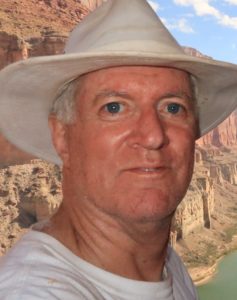
In 2015 he went back on a day hike and got past that point –the cliff had been chipped out some, he said– before turning around.
And then, in the spring of 2016, Canyon John, the McDonald brothers, and one of Jim McDonald’s sons, Michael, hiked all the way down, to Nankoweap Creek and then on to the Colorado River. Lenny, who has been hiking with Canyon John since 2000 and has spent about 30 nights in the canyon, wasn’t on that trip so he had never hiked the Nankoweap. And, of course, neither had I.
* * *
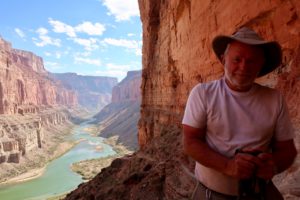
In the Grand Canyon spectacular scenery is commonplace, there is another picture postcard around every corner. Words can’t describe it; photographs don’t do it justice. You pretty much have to go and see it for yourself.
Outside of the fellowship, and a certain sense of accomplishment, the highlight of the trip, for all of us, I think, was the hike down to the Colorado River and the Anasazi granaries, which were cut into a sandstone cliff above the river around A.D. 1100. We climbed up there, soaked up what folks who know more than I do say is the most amazing view in the Grand Canyon, and then had lunch on the beach next to the Colorado. What a day!
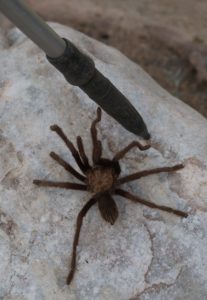
But there are all sorts of other memories:
When we got up on that first morning in the canyon Lenny spotted a tarantula a couple of feet from his tent. Biggest spider I ever saw, two or three inches across. It was a hairy, scary looking thing but, I’ve read, tarantulas are only mildly poisonous. Some people keep them for pets; we left this one alone.
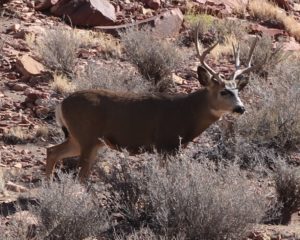
Later that week I woke up to a commotion caused by a mule deer, a buck with a big rack, who was running hard when he passed close by our tents. Jim, who was up early, was the only one who saw him. But after breakfast Lenny, David and I hiked up the draw and, lo and behold, there he was, a ten-pointer. He saw us but he didn’t run away. Instead, he moved ahead of us up the draw, keeping his distance but stopping sometimes to stare, wondering perhaps, “What are you guys doing here?”

There were a lot of beautiful wild flowers blooming in the canyon. I don’t know their names, but I brought back pictures.
On the way down into the canyon, at Marion Point, we saw our first petroglyphs. Later we saw more of them, upstream a little way from our camp, drawn on a large, reddish-brown bounder. Canyon John looked them up somewhere and told us,
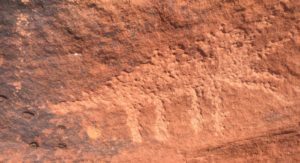
“Archaeological studies on these petroglyphs indicate they were placed on this rock around 1050-1175 A.D.”
I looked for Indian pottery but didn’t find any. However, we saw several broken of pieces of pottery found by others and left at our campsite.
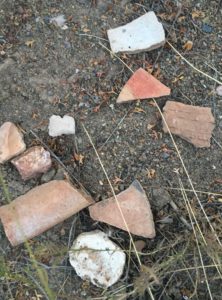
There was one tool, the white stone at the bottom of the photo. It was still sharp enough to butcher an animal. We left everything like we found it, of course. Removing artifacts from the canyon is not permitted.
* * *
OK, enough about what we saw. Tomorrow we’ll go back to the trail — The Fall[s], The “Rescue,” and The Future.
Continued tomorrow.